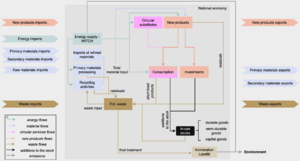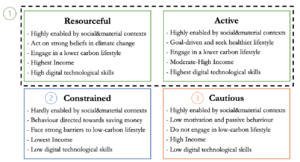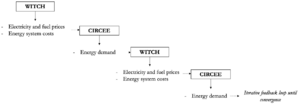CIRCEE
General Scope and Connection with Climate Mitigation
Introduction
The decarbonization of our production processes and consumption habits plays a key role in achieving long-term climate targets. One effective way to achieve this is by shifting from a linear economic system to a circular one, which emphasizes resource efficiency and reducing Greenhouse Gas emissions. Unlike the traditional linear economy, which relies on a "take-make-dispose" model, the circular economy aims to keep resources in use for as long as possible, minimizing waste and reducing the need for new resource extraction. This shift can lead to significant environmental benefits including reduced greenhouse gas emissions, lower energy and material consumption and improved resource efficiency. With the ongoing energy transition, the demand for metals required in low-carbon technologies and various end-use applications is rising, consequently exerting additional pressure on resources. Furthermore, population growth and digitalization contribute significantly to these pressures. Circular economy strategies such as product design for durability and recyclability, closed-loop material flows, and extended producer responsibility can help reduce the carbon footprint of industries and products, while also creating new business opportunities, enhancing resource security, and reducing the impact of resource price volatility on economies.
Assessing the full potential of a circular economy requires a macro-level and integrated assessment approach that addresses the complex interdependencies and trade-offs between environmental, social, and economic objectives. Policy support, lifestyle changes, innovation, and new business models such as sharing and digitalization models are key enablers for the transition to a circular economy, as well as a deep understanding of the underlying drivers and barriers. As these policies and lifestyle changes are key in driving the transition toward a circular economy, understanding their implications is essential. However, assessing the impacts of a circular economy on socio-economic-climate systems remains a complex and challenging task. The integration of the circular economy (CE) poses many challenges to the Integrated Assessment Models (IAMs) and macroeconomic modeling community, including accounting for physical material flows and industrial ecology aspects.
CIRCEE (CIRCular Energy Economy), developed by the RFF-CMCC European Institute on Economics and the Environment, addresses these challenges by developing a stylized dynamic general equilibrium model, soft-linked to the IAM WITCH and the LIFE model of Pettifor, Wilson, and Agnew (2023), that integrates key industrial ecology aspects and households’ low-carbon lifestyle heterogeneity. Our framework captures the dynamic feedback loops between physical and economic systems and assesses the trade-offs and synergies between different sustainability objectives. The stylized model will serve as a modeling starting point for the IAM community and will help map CE strategies into existing climate scenarios.
Model Scope
CIRCEE is a stylized dynamic general equilibrium model that monitors physical material and waste stock/flows. It incorporates key industrial ecology principles to evaluate how circular economy strategies and enablers can decrease future greenhouse gas emissions and enhance resource efficiency, especially in resource-poor economies. The focus of CIRCEE is on countries that may become relatively less reliant on resources in the long run due to the adoption of circular economy strategies and new business models, such as the sharing economy and digitalization. Digital technologies play a significant role in shaping the discourse on the circular economy. The adoption of digital technologies with the emergence of new technologies such as Computer Aid Design, Building Information Modeling software and digital sourcing platforms can help accelerate the transition toward a circular economy. The model takes a broad perspective of circular economy strategies and enablers to provide a broader perspective on the socio-economic-climatic implications of a circular economy.
**
The economy is populated by heterogenous households, good-producing sectors and the government. On the demand side of the economy, there exist 3 types of households differentiated by their low-carbon lifestyles and liquidity constraints. The lifestyles that characterize households are those outlined in the Pettifor, Wilson, and Agnew (2023) Lifestyle Framework. Households choose to consume different types of goods; non-durables, semi-durables, durable and “housing” goods, and different types of services, such as home-produced energy services, sharing energy services, and repairing services. They make intratemporal choices regarding the composition of their consumption basket (e.g. consuming a sharing energy service rather than home-producing it) and intertemporal choices between different types of assets available to them (capital, durable and semi-durable). In CIRCEE, owners can make their durable goods available for rent to other individuals during the time they are not using them and are willing to rent them. The goods are brokered online by a digital matching platform.
On the supply side of the economy, the economy is populated by 9 sectors producing the following products: primary material, secondary material, non-durable good, semi-durable good, durable good, capital good, sharing energy services, repairing services, and housing. All sectors, except the repairing sector, produce from labor, capital, energy (electricity and fuels), and material (primary and secondary) inputs. The repairing sector produces from labor and capital only. The production structure of the economy is economically and physically consistent. It considers key thermodynamic limits such as ruling out the 100 percent recycling and repairing scenario, a minimal material balance condition, a thermodynamic efficiency condition, physical resources stock and flows, and volume-preserving CES functions. The energy supply side is exogenous of CIRCEE. CIRCEE is soft-linked to the IAM model WITCH from the RFF-CMCC European Institute on Economics and the Environment (EIEE) to assess the overall GHG mitigation potential of circular economy strategies.
The government levies taxes, implements circular economy policies, and makes public expenses. In addition, the model considers trade flows between the domestic economy and other countries since imports and exports of goods may have different material intensities. Also, it is important to consider the potential negative consequences of transitioning toward a circular economy for resource-rich economies, which can lead to issues of justice. While reducing the import of resources can benefit economies with limited resources, it may have a negative impact on resource-rich economies, resulting in a decrease in their GDP. Therefore, it is important to recognize that the circular economy might be a zero-sum game.
The current geographical scope of CIRCEE is Japan and South Korea (and later on, France). These countries are being studied because they are among the least resource-rich economies in the OECD. Circular economy and new business models are essential for addressing climate change, improving resource security, and promoting economic growth in these countries. Furthermore, the main industries in Japan and South Korea depend heavily on key materials for their production processes, including semi-conductors, automobiles, steel-making, ships, and the ICT industry. As a result, these countries are particularly vulnerable to fluctuations in material prices and issues related to the security of supply. The growing demand for materials in new low-carbon technologies and digitalization, and the heavy reliance on China's exports, further exacerbate the challenges. To address these challenges, both countries have accelerated their transition toward a circular economy system and implemented various policies, such as Japan's Circular Economy Vision 2020 and South Korea's Framework Act on Resource Circularity. While data availability will determine which additional OECD countries can be added to the model in the future, users may add other countries themselves, provided there is enough data to calibrate the model.
Users of CIRCEE can simulate the model for any desired number of years, using 2019 as the base year value, provided that the users have a clear trajectory of exogenous variables. Longer time horizon can also be run to avoid any end-of-horizon effect, but 2100 is generally sufficient. Results are usually reported for the period 2019-2060. The model has a yearly time step.
**
CIRCEE allows the study of many scenarios, especially Shared Socioeconomic Pathways (SSPs) and Low Energy Demand (LED), that integrate different narratives for the circular economy. These scenarios are implemented matching the story lines and quantification throughout the model to generate different scenarios.
Model Development
- Status: in progress.
- Environment: The model uses the open-source modelling platform dynare which requires matlab, GNU Octave or julia.
- Documentation: in progress. Not yet available.
- Source code: link available end of May 2024 (M24 in CIRCOMOD).
Circular Economy Features
R Words coverage and implemented in the model
CIRCEE offers a comprehensive outlook on the socio-economic-climatic consequences of implementing circular economy practices through the integration of different strategies. At the macro-level, CIRCEE encompasses most R strategies. The first ones are Recycle R8, which involves using secondary (recycled) materials instead of primary (virgin) materials. Increasing material circularity through strategies is key for the vision of a circular economy. The second ones relate to Repair R4, Reuse R3 and Refurbish R5, which involves substituting newly produced goods with repaired or second-hand items to extend the lifespans of products, replacing new goods with services (such as in the sharing economy), intensifying the use of long-lived goods (also in the sharing economy) and refurbishing housing. The third encompasses Rethink R1, Reduce R2 and Refuse R0, which involves enhancing material productivity through technological advancements, replacing material inputs with non-material ones, use lighter materials, adopting Green Product Design to increase the durability and recyclability of goods, sharing products and services, higher use rates, and reducing the consumption of certain goods for which the same benefits can be achieved through alternative means. These strategies emphasize the significance of reducing material flows within the economy. Green product design plays a crucial role in slowing down material flow by creating more durable and repairable goods. However, due to its inherent macrostructure, CIRCEE cannot fully capture the incentives that drive firms to engage in green product design. To support the economy's transition toward circularity, CIRCEE integrates various exogenous policies and economic instruments, which are described in detail throughout the model's analytical description.
CE strategies and connexion with climate change mitigation.
CIRCEE integrates exogenous instruments, depending on different narratives, to help the economy in its way to circularity. Each instrument have a direct or indirect impact on GHG emissions.
1. Substitute secondary (recycled) materials for primary (virgin) materials
Tax on landfill waste ★*
Subsidies towards the recycling sector ☆**
Mandatory recycling targets ★
Green product design to increase the recyclability of goods ☆
Extended Producer Responsibility (EPR) fees ☆
Shock on the recyclability rate of waste ★
Shock the share of secondary materials in the production function of sectors ★
Shock on material prices ☆
2. Substitute repaired and second-hand for newly produced goods
Discount/no VAT for repairing services ☆
Repair bonus ☆
Robotization of the repair sector ☆
Shock on second-hand goods demand ★
Reduced transaction costs on second-hand markets ☆
Shock households' preferences ★
3. Replace new goods with services (sharing economy)
Discount on sharing services price ☆
Reduce access fee to sharing digital platform ☆
Shock households' preferences ★
4. Increase the utilization rate of long-lived goods (sharing economy)
Shock on the utilization rate of durable goods ★
5. Refurbish housing
Shock on the refurbishing rate of the economy ★
6. Improve material productivity via technological change
Shock on the material leakage rate of sectors ★
Shock on material productivity ★
Subsidies towards R&D ☆
7. Substitute non-material inputs for materials
Shock the substitution elasticity between non-resourceresource inputs and resource inputs for key sectors ★
8. Green Product Design to increase longevity of goods
Decrease the depreciation rate of durable, semi-durable and capital goods ★
EPR fees to incentivize green product design ☆
9. Reduce the consumption of certain goods
Shock households' preferences and expenses for certain types of goods ★
Reduce the demand for foreign goods that are relatively more material-intensive ★
Legends :
*★ : direct impact on GHG mitigation
**☆ : indirect impact on GHG mitigation
Synergies and trade-off between the R word in the context of the stylized model
On the demand side, in response to exogenous incentives, households make inter-temporal trade-off between different kind of assets, such as newly-produced capital and durable goods, and second-hand durable goods. Besides, households make also intra-temporal trade-off between different kind of goods and services. For instance, when a durable good such as a car reaches the end of its useful life, households have three options to continue consuming the energy service "mobility":
- Purchase a newly produced car, which requires new materials and energy inputs. However, the new car typically has higher energy efficiency than the old one.
- Continue consuming the energy service without purchasing a new durable good by engaging with the repairing service sector to extend the life of the old car. However, this option may have a negative impact on the overall energy efficiency of durable goods.
- Participate in the peer-to-peer sharing market to use a car, without directly owning it, jointly with energy.
- Participate in the second-hand durable goods market, where they can purchase a used car that is not yet at the end of its useful service life.
On the supply-side, sectors make intra-temporal trade-offs between different input mix. For instance, firms may choose to increase the use of recycled materials in their production process in response to external incentives promoting more circular behavior.
Insights for Analytical Framework
- Key mechanisms and interactions within CE strategies that lead to changes in GHG emissions.
- Tool exploration (demonstrating ideas before implementing them in large-scale quantitative models)
- Communication key CE dynamics (to the broader audience)
Refinement, Integration, Future Development
Refinement process
CIRCEE can be improved by including results from additional bottom-up models. The results can be used to refine the calibration of CIRCEE or integrate other circular economy techniques that are currently unavailable in CIRCEE due to insufficient data and literature on the subject. For instance, detailed bottom-up models for crucial sectors, such as transport and construction, can be soft-linked to CIRCEE model to improve its capabilities in evaluating circular economy (CE) strategies.
For example, within CIRCEE, the rates of housing depreciation, housing demolition, and waste generated from demolition are derived from the bottom-up model simulation of building demand by Deetman et al. (2020). This bottom-up model captures various intricacies of the building sector that CIRCEE cannot, such as the influence of factors like floorspace demand, urbanization, national building codes, and refurbishing rates on total building demand and the demolition of buildings. These factors directly affect the generation of construction and demolition wasteand building demand in CIRCEE, which in turn impacts material and energy demand, thereby influencing greenhouse gas (GHG) emissions.
Integration
CIRCEE can be easily linked with other IAMs in a similar manner to WITCH. In particular, the primary output of CIRCEE that is utilized as an input in IAMs is the energy demand. From the energy demand, IAMs simulate the trajectory of energy prices of the energy system, and future GreenHouse Gases emissions that are fed into CIRCEE. From the new energy prices, CIRCEE feds back to the IAM the new energy demand. The user would repeat this cycle until the two models converge, implying that the energy demand, energy prices, and greenhouse gas (GHG) emissions stabilize. Note that if the material requirement of power generation technologies are present in the IAM, it can be linked to the material/waste stock and flows of CIRCEE.
Future features of the model.
- CIRCEE's current version includes exogenously technological change that is directed towards improving material productivity and recycling quality. A future version will include an endogenous representation of this technological change;
- CIRCEE's stable version does not include second-hand markets, though an unstable version exists. The future stable version will enable the exchange of durable goods in second-hand markets;
- The current version of CIRCEE incorporates two forms of waste management, namely recycling and incineration/landfill. However, there is currently no connection between incineration in CIRCEE and the energy-technology module of WITCH. In a future version, a new energy technology related to waste incineration will be added to the WITCH module.



